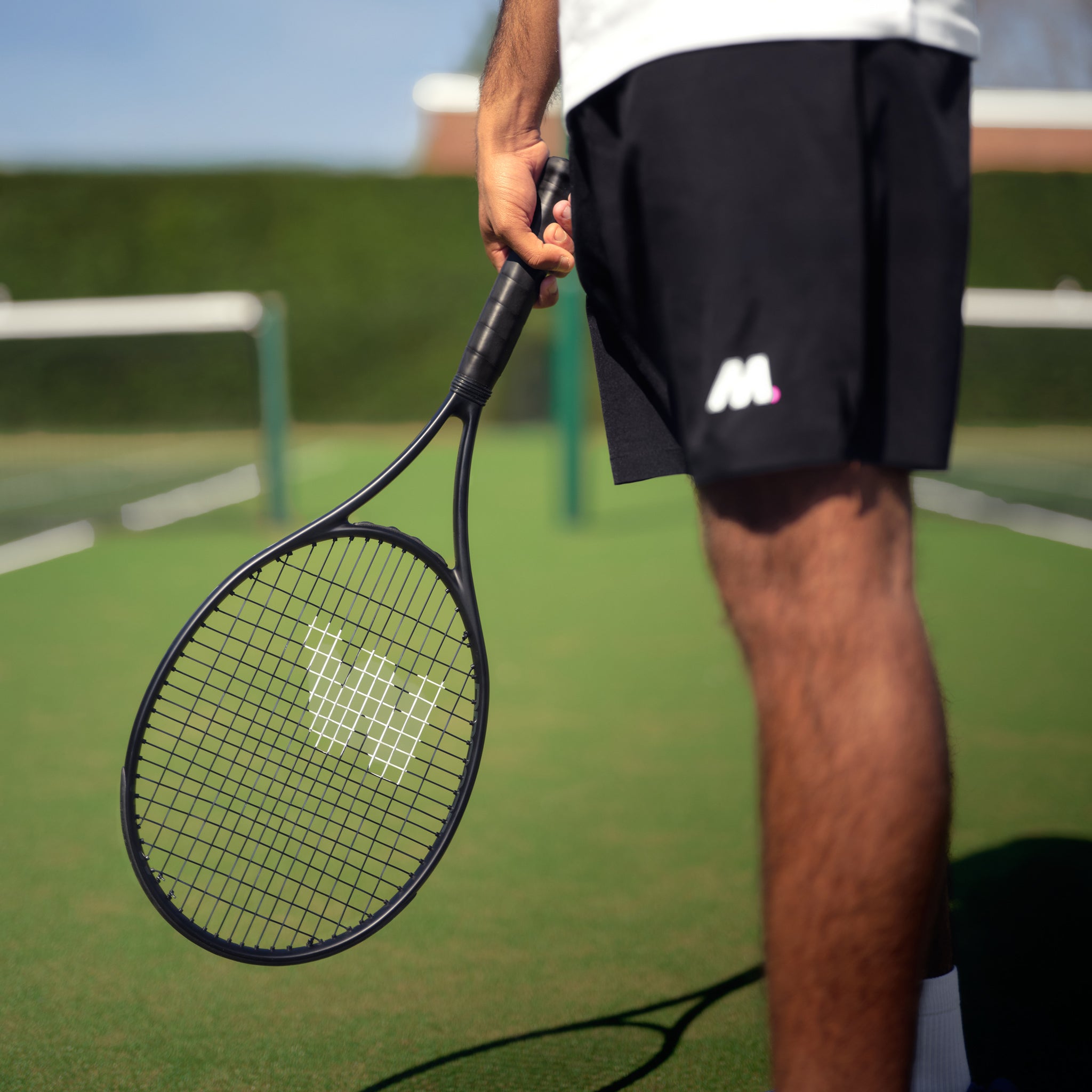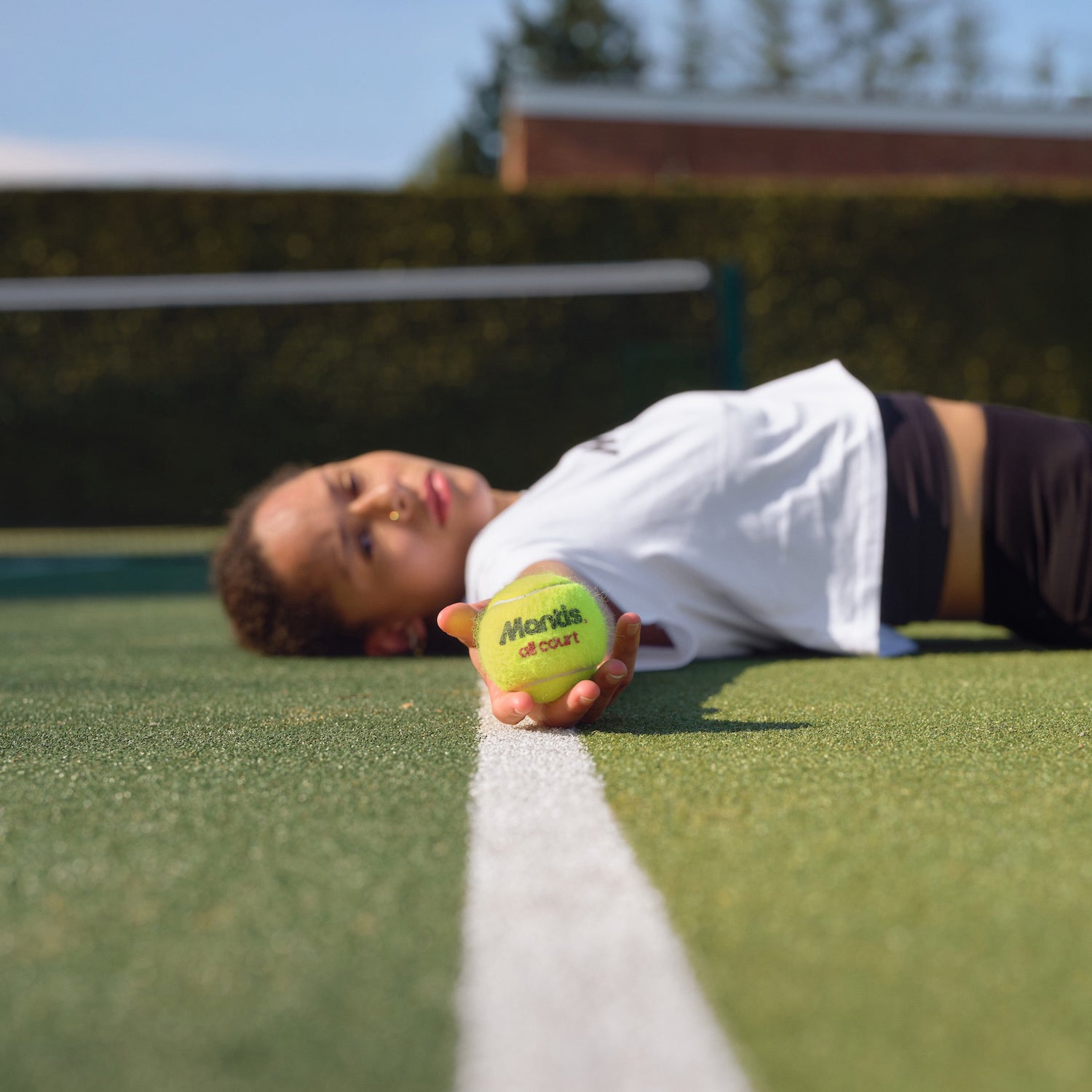
That satisfying psst sound you hear when cracking open a new can of tennis balls? It’s one of the best sounds in the game. But it’s also the beginning of the end for that ball's bounce. The secret of how to keep tennis balls fresh is simple: you have to stop the air from escaping their core by storing them in a pressurised container. Essentially, you need to recreate that 'new can' environment after every single match, and Mantis has the high-quality Mantis tennis balls to get you started.
Why New Tennis Balls Go Dead So Quickly
Ever wondered why a brand-new set of balls can feel lively and perfect for a few hours, only to lose its pop by your next hit? It all comes down to pressure. Before we get into how to keep them fresh, it's worth understanding why they go ‘dead’ in the first place. Here at Mantis, we know a great game starts with reliable gear, which is why our high-quality Mantis tennis balls are designed for peak performance right out of the can.
A fresh tennis ball is basically a hollow rubber sphere pumped full of pressurised air—usually around 12 psi (pounds per square inch) higher than the atmosphere around it. This internal pressure is precisely what gives the ball that crisp, consistent bounce every player loves.
The Role of the Pressurised Can
That iconic can is far more than just packaging; it's a miniature pressure chamber. Manufacturers and retailers across the UK use these pressurised cans to maintain the ball's internal pressure, preserving both its bounce and the texture of its felt for months on end. If you're curious about the logistics behind this, you can read the full research about tennis ball supply chains on spglobal.com.
But the moment you break that seal, the physics of pressure equalisation kicks in. The higher-pressure air inside the ball immediately starts seeping out through the porous rubber, trying to match the lower atmospheric pressure outside. It's a one-way street without the right equipment.
The second a can is opened, the countdown begins. A ball left in an unsealed can loses its bounce at almost the same rate as one rolling around loose in your tennis bag.
It's More Than Just Pressure Loss
While escaping air is the main culprit, two other factors are working against your tennis balls:
- Core Degradation: Every time you hit a forehand or the ball smacks against the court, the rubber core gets compressed. Over hundreds of these impacts, the rubber naturally loses its elasticity and becomes less responsive. It just gets tired.
- Felt Wear: That fuzzy yellow felt (or nap) isn't just for looks; it's crucial for the ball's aerodynamics and your ability to generate spin. As you play, the felt gets matted down and worn away, particularly on abrasive hard courts. This reduces grip and makes your shots fly less predictably.
Understanding this natural process of decay is the first step. Once you know what you're up against, you can take smart, simple steps to extend the life of your tennis balls and guarantee a better experience on the court.
Choosing the Right Tennis Ball Pressurizer
Now that we’ve covered the science, let's get practical. It’s a common myth among players that the original can offers any real protection after it’s been opened. The truth is, once you break that seal, it’s no better than your kit bag at stopping air leakage. For players who are serious about their performance, pairing quality Mantis tennis balls with a proper storage solution is the only way to maintain that fresh-out-of-the-can bounce.
The only truly effective method for keeping tennis balls fresh is a dedicated tennis ball pressurizer. These devices work by creating an external pressure environment that matches the ball's internal pressure, which is typically around 12-14 psi. This equalisation effectively pauses the natural process of air seeping out, preserving the ball's bounce for weeks or even months longer.
Screw-Top Pressurizers
These are the pressurizers you’ll see most often and are generally the most budget-friendly. They look like sturdy tubes that hold three or four balls. You simply pop the balls inside, seal the lid, and twist it down to compress the air and build up pressure.
- Pros: They're simple to use, affordable, and easy to toss in your bag. With no extra parts or pumps, they’re a convenient choice for most club players.
- Cons: The pressure they generate is limited by how tightly you can physically screw the lid. While they definitely slow down pressure loss, they might not fully restore or maintain the exact original psi.
Pump-System Pressurizers
For the player who wants maximum performance and longevity from their tennis balls, a pump-system pressurizer is the way to go. These devices come with either an integrated or a separate hand pump, giving you precise control over the pressure inside the container.
You seal the balls inside, then use the pump to increase the internal pressure to a specific psi—often displayed on a built-in gauge. This ensures the external environment perfectly matches, or even slightly exceeds, the ball's original internal pressure.
At Mantis, we find that pump systems offer the most reliable and consistent results. They don't just slow down the aging process; they effectively halt it, keeping your balls playing like new for much longer. It's a real investment in consistent performance.
Ultimately, the right choice comes down to your playing habits and budget. If you're a casual player hitting the courts once or twice a month, a screw-top model is a huge improvement over no pressurizer at all.
However, for serious competitors and coaches who are cracking open multiple cans a week, a pump system offers far greater value and performance consistency in the long run.
Pro-Level Habits: How They Keep Tennis Balls Fresh
For committed players, knowing how to keep tennis balls fresh isn't just about what you do after a match—it’s about the small, consistent habits that make a huge difference. Think of it less as a chore and more as part of your training routine. Here at Mantis, we're obsessed with helping players get the most from their gear, including our premium Mantis tennis balls.
One of the biggest mistakes we see? Leaving the kit bag in the car. It’s easily done, but those temperature swings are a ball's worst enemy. A hot car boot in summer rapidly increases the pressure inside, forcing air out through the rubber core. A freezing garage in winter can make the rubber brittle, permanently killing its bounce.
The single best thing you can do is bring your gear inside. A stable, room-temperature environment is non-negotiable.
Ball Rotation and Cleaning: The Small Details That Count
Here's a habit that the pros live by: ball rotation. Instead of hammering a single can of three balls until they're completely dead, get into the habit of rotating between two or even three sets. Use one set for Monday's practice and another for Wednesday's match. This simple change gives the rubber and felt time to recover between sessions, dramatically extending the playable life of all your balls.
Cleaning is another detail that often gets overlooked, especially after a hit on a damp or clay court. Take a moment to gently brush any loose dirt from the felt with a soft-bristled brush. If the balls are damp, let them air dry completely before popping them back into a pressuriser. Putting them away wet is a surefire way to damage the felt and the adhesive holding it together.
A ball’s lifespan isn’t just about pressure; it’s about the environment it’s kept in. Humidity plays a massive role in how quickly the felt and rubber core degrade, impacting overall freshness.
Just how much does the environment matter? This chart breaks it down perfectly.

As you can see, jumping from a low-humidity environment (30%) to a highly humid one (70%) can literally cut a ball’s effective lifespan in half. It’s a stark reminder of why keeping your balls dry and at a stable temperature isn't just a suggestion—it's a core principle for any serious player.
How Dead Balls Are Hurting Your Game
Knowing how to keep tennis balls fresh isn’t just about saving a bit of cash; it's a direct investment in your on-court performance. Using lively, pressurised balls, like the ones in our guide to the best hard court tennis balls, makes sure every practice is productive. But what really happens when you keep playing with dead ones?
A dead ball completely changes the game. When a ball loses its internal pressure, it just doesn't bounce as high. Simple as that. This creates a lower, much less predictable trajectory off the court, forcing you to constantly adjust your technique. You’ll find yourself having to get lower and lift the ball far more, which can totally disrupt the natural rhythm of your swing and lead to a frustrating number of unforced errors.
The Impact on Spin and Control
It's not just about a weak bounce; the condition of the felt is absolutely critical. Once that felt becomes worn and matted, your ability to generate spin drops off a cliff. That fuzzy nap is what your strings need to grip the ball to impart topspin on a forehand or a nasty slice on a backhand.
Without that grip, the ball skids off the strings with far less rotation. This makes it incredibly difficult to control your depth or shape your shots. You lose the confidence to really hit out, because you can no longer rely on spin to bring the ball down inside the lines. It’s a common frustration, especially with the recent surge in tennis participation across the UK.
At Mantis, we argue that consistent practice with fresh balls is non-negotiable for any player serious about developing their game. Training with dead balls ingrains bad habits, forcing compensations in your technique that are incredibly hard to unlearn later on.
In 2022, the number of adults playing tennis in Britain rose by a staggering 43% to 4.7 million—its highest level since 2017. With so many more players on court, the demand for quality, reliable equipment has never been greater, because ball freshness has a direct impact on the quality of every game played.
Sustainable Choices and the Future of Tennis
Knowing how to keep your tennis balls fresh is about more than just getting a better bounce; it’s a simple, meaningful step towards making our sport more sustainable. Here at Mantis, we're deeply committed to tennis and its future, and that means facing the environmental impact of our game head-on. As a brand, we believe in taking care of your gear, from your racket to the very last Mantis tennis balls in your bag.
The reality is pretty stark: millions of tennis balls end up in landfills every single year. Once there, their rubber cores can take hundreds of years to break down. Extending the life of your balls is the most direct way any player can help reduce that waste. Every time you play a match with a re-pressurised ball, that’s one less new can opened and one less old ball in the bin.
Aligning Your Habits with Industry Innovation
The good news is, the industry is starting to catch on. We're seeing some great innovations alongside various recycling programmes that are paving the way for a greener future. When you choose to look after your balls, your personal habits slot in perfectly with this wider, eco-conscious movement.
By choosing to preserve your tennis balls, you are actively participating in a larger effort to make tennis more sustainable. It's a small change in your routine that contributes to a significant, positive shift for the entire sport.
Adopting simple preservation techniques is a clear win-win. Data from the UK market shows that using pressure maintenance devices can extend a ball's life by up to three times. Think about it—that saves you money while seriously cutting down on environmental waste. At Mantis, we champion these efforts, encouraging every player to think about the entire lifecycle of their gear.
Your Top Tennis Ball Questions Answered
Even the most dedicated players have questions about keeping their tennis balls in top shape. There are plenty of myths floating around, so let's clear the air. Here at Mantis, our goal is to give you the straightforward advice you need to get the best performance from your gear, like our Mantis tennis balls, every time you step on the court.
Does Storing Tennis Balls in the Freezer Actually Work?
This is a stubborn myth, but the short answer is no. Putting tennis balls in a freezer or fridge is a bad idea.
Far from preserving pressure, the extreme cold makes the rubber core brittle. It can also seriously damage the adhesive that holds the felt in place. Any tiny benefit you might imagine is completely outweighed by the potential for permanent harm to the ball. For best results, always stick to room temperature and, ideally, a proper pressuriser.
Key Takeaway: Skip the freezer. It does more harm than good to the ball’s core and felt. Room temperature storage, preferably in a pressuriser, is the only method that reliably extends a ball's life.
How Long Do Opened Tennis Balls Last?
Honestly, this all comes down to how you store them. Once a can is opened, those balls start losing pressure immediately.
Without a pressuriser, a can of balls will lose its ideal bounce within just one to two weeks of regular play. A casual player might find them usable for up to four weeks, but the drop in performance is huge and you'll definitely feel it.
On the other hand, using a quality tennis ball pressuriser can keep them playing like new for several months. At that point, the life of the ball isn't about pressure anymore—it’s about how worn out the felt gets.
Does Playing on a Wet Court Ruin Tennis Balls?
Yes, absolutely. When the felt on a tennis ball gets soaked, it absorbs a surprising amount of water. This makes the ball incredibly heavy, fluffs up the felt, and makes its bounce completely unpredictable.
Even worse, the moisture can cause long-term damage by weakening the rubber core and the adhesive bonds. If your balls do get wet, make sure you let them air dry completely at room temperature before you even think about storing them.
At Mantis, we believe precision gear is the key to better performance. Our equipment is designed for players who are serious about their progress. Explore our range of high-performance tennis rackets, strings, and balls to take your game to the next level.









